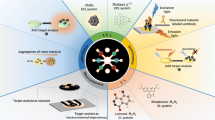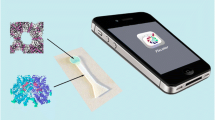Abstract
In this paper, we combined lab-on-paper technology with biosensor techniques to fabricate a new analytical tool for hypoxanthine detection. The combination of these two technologies produces a quick, selective, and cost-effective analytical metrology for detection of hypoxanthine in meat samples. The paper-based colorimetric biosensor was developed based on dienzyme catalytic reactions. In presence of hypoxanthine, xanthine oxidase (XOD) catalyzes to form hydrogen peroxide (H2O2). Then H2O2 couples with o-dianisidine in the presence of horseradish peroxidase (HRP), resulting in a brown color. The color intensity of the detection zone on the paper was imaged using a scanner. For quantitative analysis of hypoxanthine, the images of the colorimetric results were analyzed with ImageJ software using a blue histogram. Under optimum conditions, the developed paper-based biosensor was found to detect hypoxanthine with a detection limit of 1.8 mg L−1 and a quantitative limit of 6.1 mg L−1. The proposed assay exhibited a linear dynamic in the range of 5–40 mg L−1. The analysis time was 5 min for triplicate measurement. This method was further evaluated by measuring the recovery of hypoxanthine added to meat samples. Finally, this method was applied to detect hypoxanthine in fresh and processed meat samples, and the results were validated against spectrophotometric detection, showing good accuracy. This simple method is cost-effective and requires no advanced instruments, offering an alternative to conventional methods.







Similar content being viewed by others
References
Albelda JAV, Uzunoglu A, Santos GNC, Stanciu LA (2017) Graphene-titanium dioxide nanocomposite based hypoxanthine sensor for assessment of meat freshness. Biosens Bioelectron 89:518–524
Andrade SCS, Mársico ET, Godoy RLO, Franco RM, Junior CAC (2014) Chemical quality indices for freshness evaluation of fish. J Food Stud 3:1–17
Caygill RL, Blair GE, Millner PA (2010) A review on viral biosensors to detect human pathogens. Anal Chim Acta 681:8–15
Chen Z, Lin Y, Ma X, Guo L, Qiu B, Chen G, Lin Z (2017) Multicolor biosensor for fish freshness assessment with the naked eye. Sensors Actuators B 252:201–208
Czauderna M, Kowalczyk J (2000) Quantification of allantoin, uric acid, xanthine and hypoxanthine in ovine urine by high-performance liquid chromatography and photodiode array detection. J Chromatogr B 744:129–138
Devi R, Yadav S, Nehra R, Pundir CS (2013) An amperometric hypoxanthine biosensor based on Au@FeNPs for determination of hypoxanthine in meat samples. Int J Biol Macromol 62:629–635
Devi R, Batra B, Lata S, Yadav S, Pundir CS (2013) A method for determination of xanthine in meat by amperometric biosensor based on silver nanoparticles/cysteine modified Au electrode. Process Biochem 48:242–249
Farthing D, Sica D, Gehr T, Wilson B, Fakhry I, Larus T, Farthing C, Karnes HT (2007) An HPLC method for determination of inosine and hypoxanthine in human plasma from healthy volunteers and patients presenting with potential acute cardiac ischemia. J Chromatogr B 854:158–164
Giacomello A, Salernot C (1977) A continuous spectrophotometric assay for hypoxanthine-guanine phosphoribosyltransferase. Anal Biochem 79:263–267
Granica M, Fiedoruk-Pogrebniak M, Koncki R, Tymecki Ł (2018) Flow injection analysis in lab-on-paper format. Sensors Actuators B Chem 257:16–22
Gonzalez E, Pariente F, Lorenzo E, Hernandez L (1991) Amperometric sensor for hypoxanthine and xanthine based on the detection of uric acid. Anal Chim Acta 242:267–273
He L-L, Cheng L, Lin Y, Cui HF, Hong N, Peng H, Kong D-R, Chen C-D, Zhang J, Wei G-B, Fan H (2018) A sensitive biosensor for mercury ions detection based on hairpin hindrance by thymine-Hg (II)-thymine structure. J Electroanal Chem 814:161–167
Hernández-Cázares AS, Aristoy MC, Toldrá F (2010) Hypoxanthine-based enzymatic sensor for determination of pork meat freshness. Food Chem 123:949–954
Hu S, Xua C, Luob J, Luoc J, Cuid D (2000) Biosensor for detection of hypoxanthine based on xanthine oxidase immobilized on chemically modified carbon paste electrode. Anal Chim Acta 412:55–61
Johnson LA, Gordon RB, Emmerson BT (1997) Hypoxanthine–guanine phosphoribosyltransferase: a simple spectrophotometric assay. Clin Chim Acta 80:203–207
Lawal AT, Adeloju SB (2012a) Progress and recent advances in fabrication and utilization of hypoxanthine biosensors for meat and fish quality assessment: a review. Talanta 100:217–228
Lawal AT, Adeloju SB (2012b) Mediated xanthine oxidase potentiometric biosensors for hypoxanthine based on ferrocene carboxylic acid modified electrode. Food Chem 135:2982–2987
Lougovois VP, Kyranas ER, Kyrana VR (2003) Comparison of selected methods of assessing freshness quality and remaining storage life of iced gilthead sea bream (Sparus aurata). Food Res Int 36:551–560
Lv M, Liu Y, Geng J, Kou X, Xin Z, Yang D (2018) Engineering nanomaterials-based biosensors for food safety detection. Biosens Bioelectron 106:122–128
Mehrotra P (2016) Biosensors and their applications–a review. J Oral Biol Craniofac Res 6:153–159
Mei DA, Gross GJ, Nithipatikom K (1996) Simultaneous determination of adenosine, inosine, hypoxanthine, xanthine, and uric acid in microdialysis samples using microbore column high-performance liquid chromatography with a diode array detector. Anal Biochem 238:34–39
Metkar SK, Girigoswami K (2019) Diagnostic biosensors in medicine – a review. Biocatal Agric Biotechnol 17:271–283
Mora L, Hernández-Cázares AS, Aristoy M-C, Toldrá F (2010) Hydrophilic interaction chromatographic determination of adenosine triphosphate and its metabolites. Food Chem 123:1282–1288
Nardo FD, Anfossi L, Giovannoli C, Passini C, Goftman VV, Goryacheva IY, Baggiani C (2016) A fluorescent immunochromatographic strip test using quantum dots for fumonisins detection. Talanta 150:463–468
Nguyen AL, Luong JHT (1993) Development of mediated amperometric biosensors for hypoxanthine, glucose and lactate: anew format. Biosens Bioelectron 8:421–431
Peng B, Fang S, Tang L, Ouyang X, Zeng G (2019) Chapter 8 - nanohybrid materials based biosensors for heavy metal detection. Micro Nano Technologies 233–264
Pierini GD, Robledo SN, Zon MA, Nezio MSD, Granero AM, Fernández H (2018) Development of an electroanalytical method to control quality in fish samples based on an edge plane pyrolytic graphite electrode. Simultaneous determination of hypoxanthine, xanthine and uric acid. Microchem J 138:58–64
Rebelo R, Barbosa AI, Caballero D, Kwon IK, Oliveira JM, SuKundu SC, Reis RL, Correlo VM (2019) 3D biosensors in advanced medical diagnostics of high mortality diseases. Biosens Bioelectron 130:20–39
Roberts B, Morris BA, Clifford MN (1991) Comparison of radioimmunoassay and spectrophotometric analysis for the quantitation of hypoxanthine in fish muscle. Food Chem 42:1–17
Roda A, Mirasoli M, Michelini E, Fusco MD, Zangheri M, Cevenini L, Roda B, Simoni P (2016) Progress in chemical luminescence – based biosensors: a critical review. Biosens Bioelectron 76:164–179
Si Y, Park JW, Jung S, Hwang GS, Goh E, Lee HJ (2018) Layer-by-layer electrochemical biosensors configuring xanthine oxidase and carbon nanotubes/graphene complexes for hypoxanthine and uric acid in human serum solutions. Biosens Bioelectron 121:265–271
Taverniers I, Loose MD, Bockstaele EV (2004) Trends in quality in the analytical laboratory. II. Analytical method validation and quality assurance. Trends Anal Chem 23:353–552
Wang Y, Wang L, Tian T, Yao G, Hu X, Yang C, Xu Q (2012) A highly sensitive and automated method for the determination of hypoxanthine based on lab-on-valve approachusing Fe3O4/MWCNTs/β-CD modified electrode. Talanta 99:840–845
Ye Y, Guo H, Sun X (2019) Recent progress on cell-based biosensors fyhbor analysis of food safety and quality control. Biosens Bioelectron 126:389–404
Zai-Hui DU, Xiang-Yang LI, Jing-Jing TIAN, Yang-Zi Z, Hong-Tao TIAN, Wen-Tao XU (2018) Progress on detection of metals ions by functional nucleic acids biosensor. Chin J Anal Chem 46:995–1004
Zhu G, Yin X, Jin D, Zhang B, Gu Y, An Y (2019) Paper-based immunosensors: current trends in the types and applied detection techniques. TrAC Trends Anal Chem 111:100–117
Funding
This study was financially supported by the Department of Chemistry, Faculty of Science and Technology, Rajamangala University of Technology Thanyaburi.
Author information
Authors and Affiliations
Corresponding author
Ethics declarations
Conflict of Interest
Montita Mooltongchun declares that she has no conflict of interest. Siriwan Teepoo declares that she has no conflict of interest.
Ethical Approval
This article does not contain any studies with human participants or animals performed by any of the authors.
Informed Consent
Not applicable in this study.
Additional information
Publisher’s Note
Springer Nature remains neutral with regard to jurisdictional claims in published maps and institutional affiliations.
Rights and permissions
About this article
Cite this article
Mooltongchun, M., Teepoo, S. A Simple and Cost-effective Microfluidic Paper-Based Biosensor Analytical Device and its Application for Hypoxanthine Detection in Meat Samples. Food Anal. Methods 12, 2690–2698 (2019). https://doi.org/10.1007/s12161-019-01626-0
Received:
Accepted:
Published:
Issue Date:
DOI: https://doi.org/10.1007/s12161-019-01626-0




